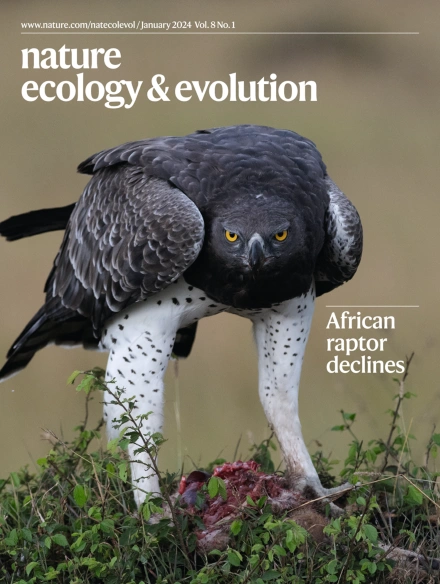宏观进化物种适应性的丧失解释了进化枝的兴衰。
IF 13.9
1区 生物学
Q1 ECOLOGY
引用次数: 0
摘要
物种多样性如何以及为什么在地质时间尺度上发生变化仍然存在争议。争论围绕着平衡动力学的存在、适应性辐射的优势以及物种形成和灭绝在驱动多样性轨迹中的相对重要性展开。我们分析了27种植物、节肢动物和脊椎动物的进化历史,在一个新的“化石出生-死亡扩散”模型下,结合灭绝和现存物种的系统发育信息,提供了过去多样化和由此产生的多样性动态的详细特征。在这里,谱系经历了物种形成和灭绝的速度,随着时间的推移不断扩散,并以不同的地层速率产生化石。进化枝多样性轨迹遵循上升和下降的动态变化,在周期性物种形成之后快速积累,而减缓和损失主要由灭绝的变化调节。多样性动态似乎不受自适应辐射或多样性依赖所预期的枝级过程的支配。相反,这些模式是从物种水平的动态中出现的,谱系往往越来越容易灭绝,随着时间的推移,物种形成的可能性越来越小。那些抵消这一趋势的物种在漫长的时间里创造并维持着生物多样性。进化支的兴衰源于物种层面的命运。本文章由计算机程序翻译,如有差异,请以英文原文为准。
Loss of macroevolutionary species fitness explains the rise and fall of clades.
How and why species diversity varies over geological timescales remains disputed. Debate revolves around the existence of equilibrium dynamics, the predominance of adaptive radiations and the relative importance of speciation and extinction in driving diversity trajectories. We analyse the evolutionary history of 27 radiations of plants, arthropods and vertebrates, with phylogenetic information incorporating extinct and extant species under a new 'fossilized birth-death diffusion' model that provides a detailed characterization of past diversification and resulting diversity dynamics. Here, lineages undergo speciation and extinction rates that diffuse continuously in time and generate fossils with rates that can vary with stratigraphy. Clade diversity trajectories follow rise and decline dynamics, with fast accumulation following recurrent speciation while slowdowns and losses are modulated primarily by changes in extinction. Diversity dynamics do not appear to be governed by clade-level processes expected from adaptive radiations or diversity dependence. Rather, these patterns emerge from dynamics at the species level, where lineages tend to become increasingly vulnerable to extinction and less likely to speciate with time. Those species that counteract this trend create and maintain biodiversity through deep time. The rise and fall of clades results from species-level fates.
求助全文
通过发布文献求助,成功后即可免费获取论文全文。
去求助
来源期刊

Nature ecology & evolution
Agricultural and Biological Sciences-Ecology, Evolution, Behavior and Systematics
CiteScore
22.20
自引率
2.40%
发文量
282
期刊介绍:
Nature Ecology & Evolution is interested in the full spectrum of ecological and evolutionary biology, encompassing approaches at the molecular, organismal, population, community and ecosystem levels, as well as relevant parts of the social sciences. Nature Ecology & Evolution provides a place where all researchers and policymakers interested in all aspects of life's diversity can come together to learn about the most accomplished and significant advances in the field and to discuss topical issues. An online-only monthly journal, our broad scope ensures that the research published reaches the widest possible audience of scientists.
 求助内容:
求助内容: 应助结果提醒方式:
应助结果提醒方式:


